fuel cap CHEVROLET TRACKER 1995 Owners Manual
[x] Cancel search | Manufacturer: CHEVROLET, Model Year: 1995, Model line: TRACKER, Model: CHEVROLET TRACKER 1995Pages: 354, PDF Size: 18.24 MB
Page 91 of 354
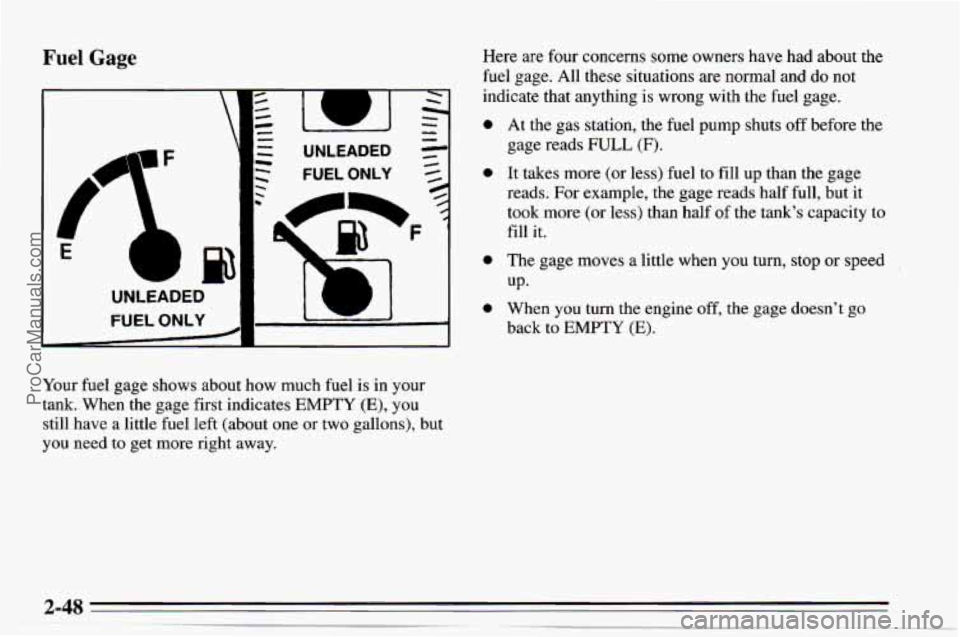
Fuel Gage Here are four concerns some owners have had about the
fuel gage. All these situations are normal and do not
indicate that anything is wrong with the fuel gage.
0
0
0
e
Your fuel gage shows about how much fuel is in your
tank. When the gage first indicates
EMPTY (E), you
still have a little fuel left (about one or two gallons), but
you need
to get more right away. At
the gas station, the fuel pump shuts off before the
gage reads
FULL (F).
It takes more (or less) fuel to fill up than the gage
reads. For example, the gage reads half full, but it
took more (or less) than half
of the tank’s capacity to
fill it.
The gage moves a little when you turn, stop or speed
UP-
When you turn the engine off, the gage doesn’t go
back to EMPTY (E).
ProCarManuals.com
Page 168 of 354
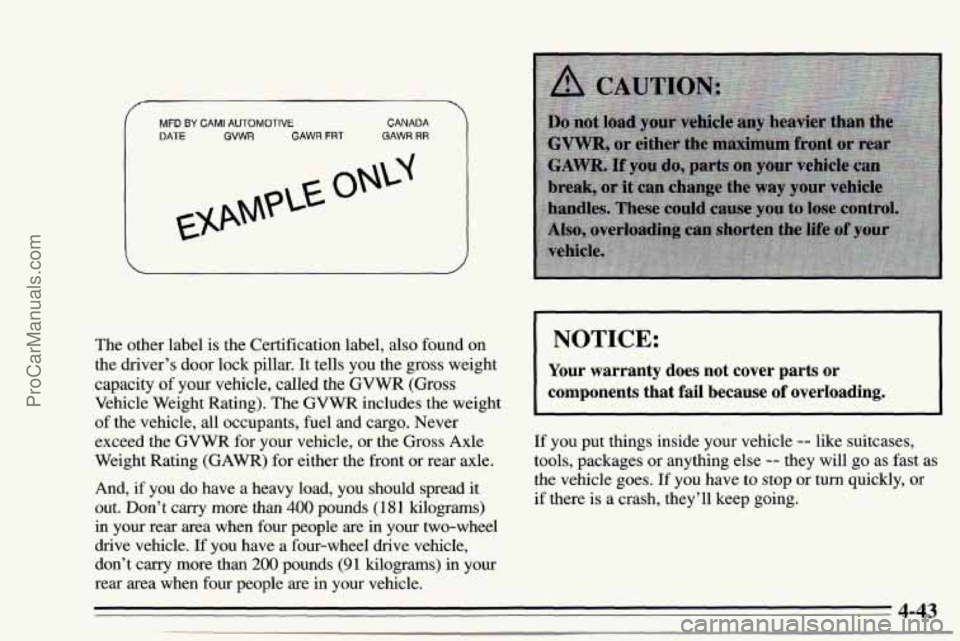
f :[:BY CAM1 AUTOMOTIVE CANADA GVWR GAWR FRT GAWR RR
The
other label is the Certification label, also found on
the driver’s door lock pillar. It tells you the gross weight
capacity of your vehicle, called
the GVWR (Gross
Vehicle Weight Rating). The GVWR includes the weight
of the vehicle,
all occupants, fuel and cargo. Never
exceed the GVWR for your vehicle, or the Gross Axle
Weight Rating
(GAWR) for either the front or rear axle.
And,
if you do have a heavy load, you should spread it
out. Don’t
carry more than 400 pounds (181 kilograms)
in your rear area when four people are in your two-wheel
drive vehicle.
If you have a four-wheel drive vehicle,
don’t carry more than
200 pounds (9 1 kilograms) in your
rear area when four people are in your vehicle.
NOTICE:
Your warranty does not cover parts or
components that fail because
of overloading.
If you put things inside your vehicle -- like suitcases,
tools, packages or anything else
-- they will go as fast as
the vehicle goes. If
you have to stop or turn quickly, or
if there is a crash, they’ll keep going.
4-43
ProCarManuals.com
Page 170 of 354
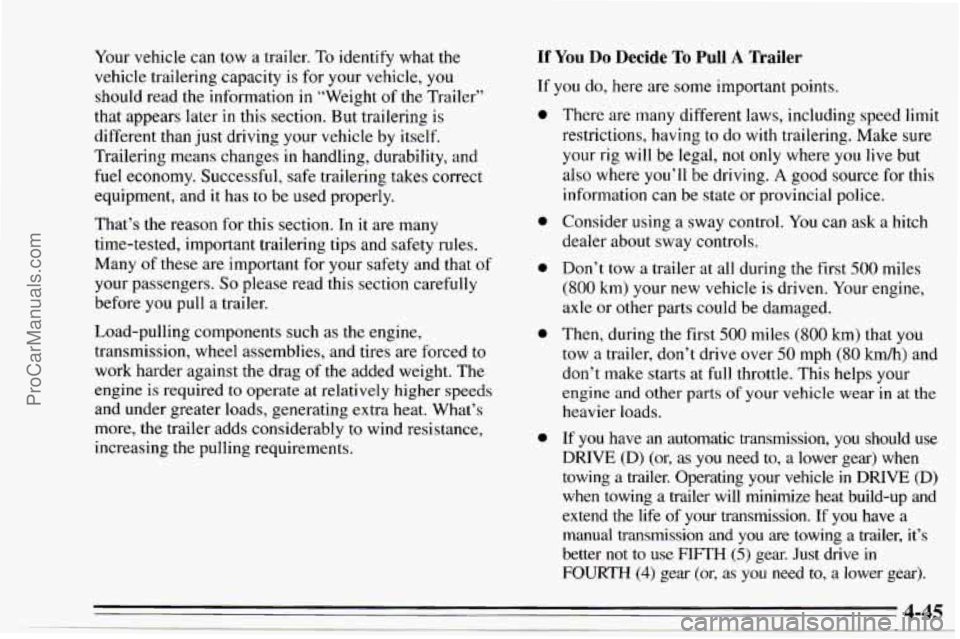
Your vehicle can tow a trailer. To identify what the
vehicle trailering capacity
is for your vehicle, you
should read the information in “Weight of the Trailer”
that
appears later in this section. But trailering is
different than just driving your vehicle by itself.
Trailering means changes in handling, durability, and
fuel economy. Successful, safe trailering takes correct
equipment, and it has to be used properly.
That’s the reason for this section. In it are many
time-tested, important trailering tips and safety rules.
Many
of these are important for your safety and that of
your passengers.
So please read this section carefully
before you pull a trailer.
Load-pulling components such as the engine,
transmission, wheel assemblies, and tires are forced
to
work harder against the drag of the added weight. The
engine
is required to operate at relatively higher speeds
and under greater loads, generating extra heat. What’s
more, the trailer adds considerably
to wind resistance,
increasing the pulling requirements.
If You Do Decide To Pull A Trailer
If you do, here are some important points.
0
0
0
0
There are many different laws, including speed limit
restrictions, having
to do with trailering. Make sure
your rig will
be legal, not only where you live but
also where
you’ll be driving. A good source for this
information can be state or provincial police.
Consider using a sway control. You
can ask a hitch
dealer about sway controls.
Don’t tow a trailer at all during the first
500 miles
(800 km) your new vehicle is driven. Your engine,
axle or other parts could be damaged.
Then, during the first
500 miles (800 km) that you
tow a trailer, don’t drive over
50 mph (80 km/h) and
don’t make starts at full throttle. This helps your
engine and other parts of your vehicle wear
in at the
heavier loads.
If
you have an automatic transmission, you should use
DRIVE (D) (or, as
you need to, a lower gear) when
towing
a trailer. Operating your vehicle in DRIVE (D)
when towing a trailer will minimize heat build-up and
extend the
life of your transmission. If you have a
manual transmission and
you are towing a trailer, it’s
better
not to use FIFTH (5) gear. Just drive in
FOURTH (4) gear (or, as you need to, a lower gear).
ProCarManuals.com
Page 215 of 354

Fuels in Foreign Countries
If you plan on driving in another country outside the
U.S. or Canada, unleaded fuel may be hard to find. Do
not use leaded gasoline. If you use even one tankful,
your emission controls won’t work well or at all. With
continuous use, spark plugs can get fouled, the exhaust
system
can corrode, and your engine oil can deteriorate
quickly. Your vehicle’s oxygen sensor will be damaged.
All
of that means costly repairs that wouldn’t be covered
by your warranty.
To check on fuel availability, ask an auto club, or
contact
a major oil company that does business in the
country where you’ll be driving.
You can also write
us at the following address for
advice. Just tell us where you’re going and give your
Vehicle Identification Number (VIN).
Filling Your Tank
- ~~~
The cap is behind a hinged door on the passenger’s side
of your vehicle.
General Motors Overseas Distribution Corporation,
North American
Export Sales (NAES)
1908 Colonel Sam Drive
Oshawa, Ontario
L1H 8P7
To take off the cap, turn it slowly to the left
(counterclockwise).
ProCarManuals.com
Page 253 of 354

Inflation - Tire Pressure
The Tire-Loading Information label which is on the
driver’s door shows the correct inflation pressures for
your tires, when they’re cold.
“Cold” means your
vehicle has been sitting for at least three hours or driven
no more than
a mile.
I
’ NOTICE:
Don’t let anyone tell you that underidation or
~ overinflation is all right. It’s not. If your tires don’t
~ have enough air (underinflation) you can get:
Too much flexing
Too much heat
Tire overloading
Bad wear
Bad handling
Bad fuel economy.
If your tires have too much air (overinflation),
you can get:
Unusual wear
0 Bad handling
Rough ride
Needless damage from road hazards. When to Check
Check your
tires once a month or more. Also, check the
tire pressure of
the spare tire.
How to Check
Use a good quality pocket-type gage to check tire
pressure. Simply looking at the tires will
not tell you the
pressure, especially if you have radial tires
-- which
may look properly inflated even
if they’re underinflated.
If your tires have valve caps, be sure to put them back on.
They help prevent leaks by keeping out dirt and moisture.
Tire Inspection and Rotation
Tires should be inspected every 6,000 to 8,000 miles
(10 000 to 13 000 km) for any signs of unusual wear. If
unusual wear is present, rotate your tires as
soon as
possible and check wheel alignment. Also check for
damaged tires or wheels. See “When It’s Time for New
Tires” and “Wheel Replacement” later in this section for
more information.
The purpose
of regular rotation is to achieve more
uniform wear for all tires on the vehicle. The first
rotation is the most important. See “Scheduled
Maintenance Services” in
the Index for scheduled
rotation intervals.
ProCarManuals.com
Page 275 of 354

Replacement Bulbs Continued
License Plate ................................. 194
GM Part No. 96053203 or equivalent
Lighter
............ GM Part No. 9433 184 or equivalent
Rear Defogger Switch
.............................
GM Part No. 96061736 or equivalent
GM Part No. 96051557 or equivalent
Rear Hazard and
Turn Signal .................... 1156
Rear Parking and Stop
......................... 1157
GM Part No. 96051558 or equivalent
Rear Wipermasher Switch
.........................
GM Part No. 96061736 or equivalent
Sidemarker
................................... 194
GM Part No. 96053293 or equivalent
Capacities and Specifications
Engine
Type ......................................... L4
Compression Ratio 8-Valve Engine
............................ 8.9: 1
16-Valve Engine ........................... 9.5: 1
Firing Order
.............................. 1-3-4-2
Fuel Delivery
......................... Fuel Injection
Piston Displacement
................... 97 CID (1.6L)
Valve Arrangement ................ In-Head “V” Type
AC Belt Tension
.............. Deflect Belt 0.24-0.3 in.
(6-9
mm) @ 22 lbs. (10 kg.) Pressure
Fan Belt Tension
Inspection
............... Deflect Belt 0.24-0.32 in.
Replacement
............. Deflect Belt 0.20-0.28 in.
(6-8
mm)
0 22 lbs. (10 kg.) Pressure
(5-7 mm)
@ 22 lbs. (10 kg.) Pressure
Thermostat Temperature Specification
.... 180°F (82°C)
ProCarManuals.com
Page 276 of 354
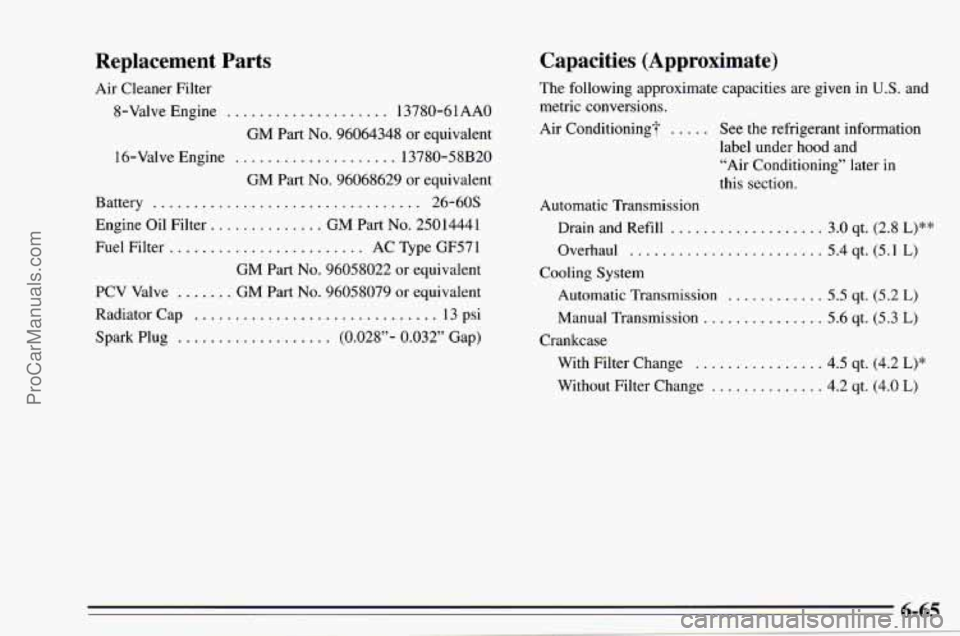
Replacement Parts
Air Cleaner Filter
8-Valve Engine
.................... 13780-61AAO
GM Part
No. 96064348 or equivalent
16-Valve Engine
.................... 13780-58B20
GM Part No. 96068629 or equivalent
Battery
................................. 26-60s
Engine Oil Filter .............. GM Part No. 2501444 1
Fuel Filter ........................ AC Type GF57 1
GM Part No. 96058022 or equivalent
PCV Valve
....... GM Part No. 96058079 or equivalent
Radiator Cap
.............................. 13 psi
Spark Plug
................... (0.028”- 0.032” Gap)
Capacities (Approximate)
The following approximate capacities are given in U.S. and
metric conversions.
Air Conditioning?
..... See the refrigerant information
label under hood and
“Air Conditioning” later in
this section.
Automatic Transmission
Drain and Refill
................... 3.0 qt. (2.8 L)**
Overhaul ........................ 5.4 qt. (5.1 L)
Cooling System
Automatic Transmission
............ 5.5 qt. (5.2 L)
Manual Transmission ............... 5.6 qt. (5.3 L)
Crankcase
With Filter Change
................ 4.5 qt. (4.2 L)*
Without Filter Change .............. 4.2 qt. (4.0 L)
ProCarManuals.com
Page 277 of 354
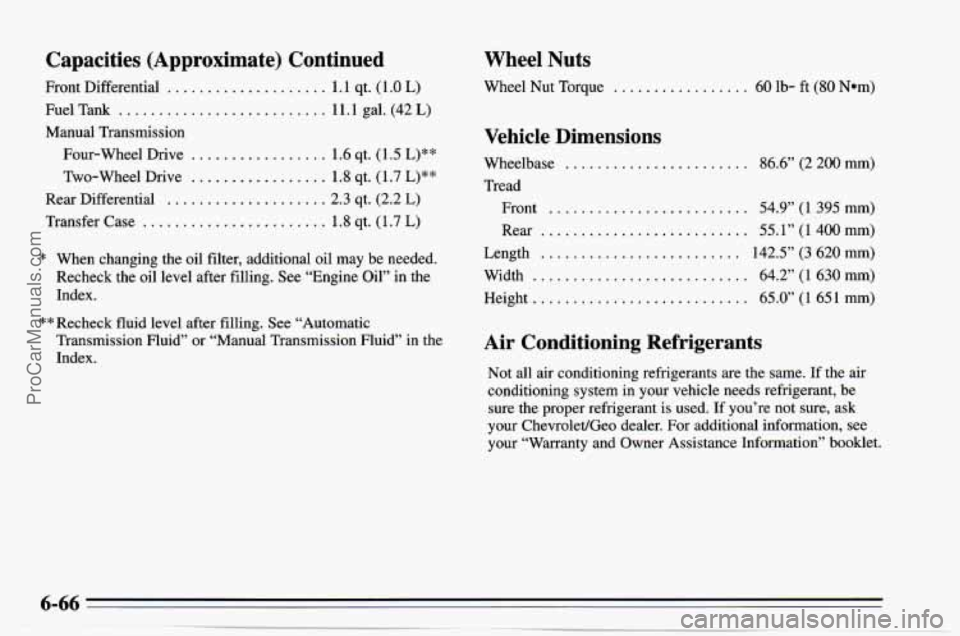
Capacities (Approximate) Continued
Front Differential .................... 1.1 qt. (1 .O L)
Fuel Tank .......................... 11.1 gal. (42 L)
Manual Transmission
Four-wheel Drive
................. 1.6 qt. (1.5 L)**
Two-Wheel Drive ................. 1.8 qt. (1.7 L)**
Rear Differential .................... 2.3 qt. (2.2 L)
Transfer Case ....................... 1.8 qt. (1.7 L)
* When changing the oil filter, additional oil may be needed.
Recheck the oil level after filling. See “Engine Oil” in the
Index.
** Recheck fluid level after filling. See “Automatic
Transmission Fluid” or “Manual Transmission Fluid” in the
Index.
Wheel Nuts
Wheel Nut Torque ................. 60 lb- ft (80 Nom)
Vehicle Dimensions
Wheelbase ....................... 86.6” (2 200 mm)
Tread Front
......................... 54.9” (1 395 mm)
Rear
.......................... 55.1” (1 400 mm)
Length
......................... 142.5” (3 620 mm)
Width
........................... 64.2” (1 630 mm)
Height
........................... 65.0” (1 65 1 mm)
Air Conditioning Refrigerants
Not all air conditioning refrigerants are the same. If the air
conditioning system
in your vehicle needs refrigerant, be
sure the proper refrigerant is used. If you’re not sure, ask
your Chevrolet/Geo dealer.
For additional information, see
your “Warranty and Owner Assistance Information” booklet.
ProCarManuals.com
Page 282 of 354

Maintenance Schedule
Every 30,000 Miles (50 000 km)
Air Cleaner Filter Replacement
Spark Plug Replacement
Engine Accessory Drive Belt Inspection (or every
Fuel Filter Replacement (or every
30 months,
Cooling System Service (or every
30 months,
24 months, whichever occurs first)
whichever occurs first) whichever occurs first)
Every 50,000 Miles (83 000 lug)
Automatic Transmission Service (severe conditions
Positive Crankcase Ventilation
(PCV) Valve
Exhaust Gas Recirculation (EGR) System Inspection
only)
Replacement
Every 60,000 Miles (100 000 km)
Engine Timing and Distributor Check
Fuel Tank Cap Gasket Replacement
Emission System Hoses Inspection
Camshaft Timing Belt Replacement
Brake Fluid Service Spark Plug Wire Replacement (or every
60 months,
Wiring Harness and Connectors Inspection (or every
whichever
occurs first)
60 months, whichever occurs first)
Every 80,000 Miles (133 000 km)
Heated Oxygen Sensor Replacement
Every 90,000 Miles (150 000 km)
Camshaft Timing Belt Inspection
Every 100,000 Miles (166 000 km)
Fuel Injector Inspection
Evaporative Emissions Canister Replacement
Engine Control Module (ECM) and Associated
Sensors Inspection
7-5
ProCarManuals.com
Page 284 of 354
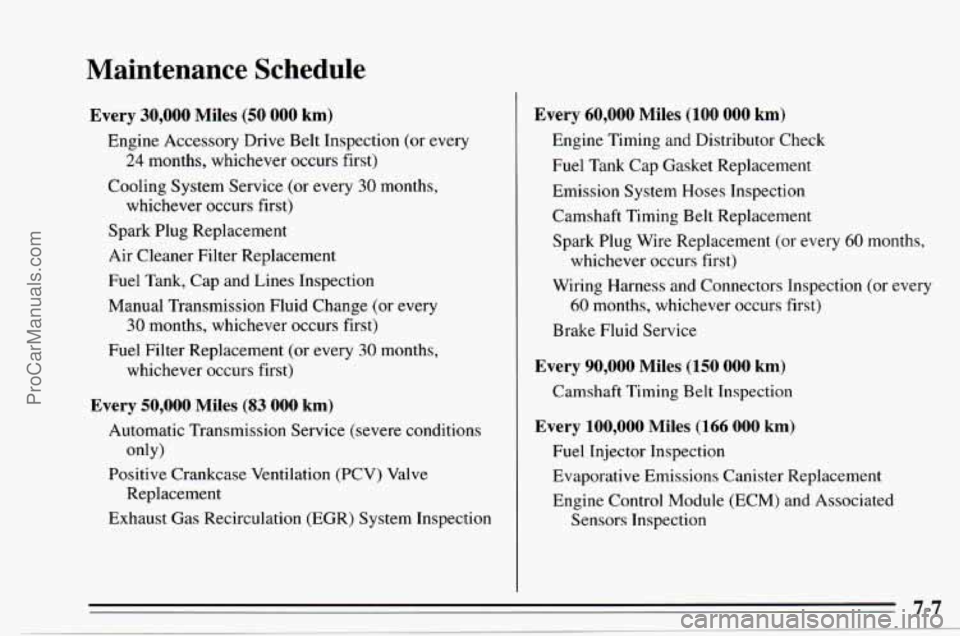
Maintenance Schedule
Every 30,000 Miles (50 000 km)
Engine Accessory Drive Belt Inspection (or every
24 months, whichever occurs first)
Cooling System Service (or every
30 months,
whichever occurs first)
Spark Plug Replacement
Air Cleaner Filter Replacement
Fuel Tank, Cap and Lines Inspection
Manual Transmission Fluid Change (or every
30 months, whichever occurs first)
Fuel Filter Replacement (or every
30 months,
whichever occurs first)
Every 50,000 Miles (83 000 km)
Automatic Transmission Service (severe conditions
Positive Crankcase Ventilation (PCV) Valve
Exhaust Gas Recirculation (EGR) System Inspection
only)
Replacement
Every 60,000 Miles (100 000 km)
Engine Timing and Distributor Check
Fuel Tank Cap Gasket Replacement
Emission System Hoses Inspection
Camshaft Timing Belt Replacement
Spark Plug Wire Replacement (or every
60 months,
Wiring Harness and Connectors Inspection (or every
Brake Fluid Service
whichever occurs first)
60 months, whichever
occurs first)
Every 90,000 Miles (150 000 km)
Camshaft Timing Belt Inspection
Every 100,000 Miles (166 000 km)
Fuel Injector Inspection
Evaporative Emissions Canister Replacement
Engine Control Module (ECM) and Associated
Sensors Inspection
ProCarManuals.com